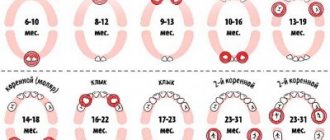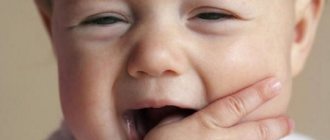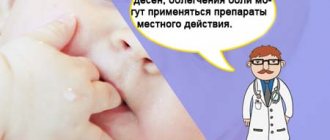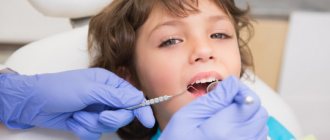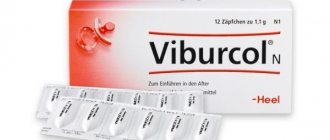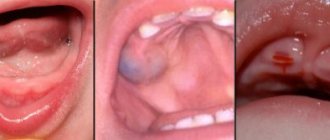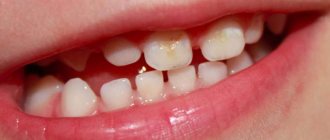Features of teething
Young parents often come across stories on the Internet about how their children cut teeth. A couple of such stories are enough to begin to mentally prepare for sleepless nights , constant whims and crying. Of course, there is some truth in this, but in most cases, eruption is not as difficult as Dr. Komarovsky says.
The timing of teething depends on various individual characteristics. So, one child’s first teeth appear at 3 months, while another’s teeth appear closer to a year. In some cases, a young mother notices the first tooth only during feeding.
Vaccinations that coincide with teething
Starting from six months, most children begin to cut their teeth. During this period, according to the vaccination calendar, the following vaccines are given:
- DPT;
- from viral hepatitis B;
- from polio;
- from hemophilus influenzae infection;
- from mumps, rubella, measles.
DTP is a vaccination necessary to protect against tetanus, diphtheria and whooping cough. AC – component against tetanus, AD – diphtheria, K – whooping cough. You can replace domestic DTP with imported analogues: Infanrix and Tetrakok.
There are three types of polio virus in the world. Vaccination against this disease can be inactivated, live or oral. The vaccine is a highly weakened or killed virus. Some time after penetration into the body with the vaccine, the causative agent of the disease is eliminated, promoting the formation of passive immunity.
The hepatitis B vaccine is the only way to protect the body from the disease. Hepatitis is a dangerous disease that has no specific symptoms. It is often accompanied by decreased appetite, intolerance to fatty foods, poor general health, yellowing and itching of the skin.
The acute form of the disease sometimes cannot be treated and becomes chronic. In this case, liver cancer and cirrhosis may develop. The hepatitis vaccine is given three times during the first year of a child’s life.
By comparing the following two tables, you can compare the periods of teething and vaccination with one or another vaccine.
When is there no reason to worry?
During the appearance of the first teeth, the baby’s behavior, as well as the reaction of the small organism, may change. The main symptoms are:
- Increased salivation . It is observed in almost all children. Saliva production increases from 10 weeks and lasts up to 4 months. At this time, it is enough for the young mother to prepare a set of bibs and change them regularly.
- Skin irritation on the chin and around the mouth. The cause of this phenomenon is the aforementioned excessive salivation. To avoid irritation, you need to wipe your baby's face with gentle movements and regularly apply a little emollient cream to the skin. It is best to use it before bed, so that the product is completely absorbed.
- While feeding a baby who has started teething, the mother experiences discomfort as the baby tries to bite the nipple . This is explained by the fact that the baby wants to scratch his gums, which is why he squeezes any objects.
Alarming symptoms
In some cases, teething causes great discomfort for the baby. This is explained by the fact that everyone has a different pain threshold. Accordingly, breaking through the soft tissue can be really painful. This is especially true for the eruption of incisors and the very first teeth. During this period, some babies refuse food, even if they are hungry. Komarovsky explains this by the fact that painful sensations during sucking intensify significantly. If the baby missed no more than 2-3 feedings, there is nothing to worry about. If the baby refuses to breastfeed for 2 days or more, you should consult a pediatrician.
Most parents are sure that diarrhea always accompanies teething . Some doctors agree. So, a large amount of saliva that a child swallows can lead to disorder. However, other experts do not share this point of view, so it is best to consult a doctor if your baby has loose stools.
What should parents remember?
- When teething, the baby's sleep is disrupted. If your baby begins to cry at night and fidget restlessly in the crib, you need to let her calm down on her own. There is no need to rock your baby to sleep or feed him milk right away.
- In some cases, , that is, small bumps, forms on the gums They dissolve on their own. If anxiety is severe, you can use a cold compress.
- Severe pain often spreads to the child’s ears and chin. Most often this happens when the incisors begin to appear. However, children may rub their chin and face when they have an ear infection. Therefore, it is necessary to consult a doctor.
- When teething, a cough may occur , because the child does not always have time to swallow saliva. If there are no other symptoms, then there is no need to worry. This also applies to a runny nose caused by saliva entering the nasopharynx. If you have other alarming symptoms, you should consult your pediatrician.
Komarovsky about teething
Dr. Komarovsky reminds concerned parents that teething is a natural and inevitable process . Young mothers and fathers should remember that this phenomenon affects the general condition of the child. Accordingly, you can only worry if the baby refuses food and his temperature rises to 38-40º C. This indicates the possible development of some disease.
Parents should know that the period of teething varies within 6 months . In this case, teeth often appear in different sequences depending on individual characteristics. It is enough to remember these two points to be prepared for anything.
Teething is an important stage in the life of any child. This point in time often coincides with the period when the effect of the antibodies that the child received from his mother ends. Accordingly, the likelihood of developing allergies and ARVI increases. In order not to confuse a cold with teething, it is enough to come for a consultation with an experienced pediatrician.
Cutting through the first teeth: recommendations from Dr. Komarovsky, when is it time to worry?
All parents watch with trepidation how their newborn baby develops. Some changes bring joy, while others cause anxiety. So, many people don’t know what to do when their baby starts teething. To distinguish this natural process from a cold and not harm the baby, you need to listen to the opinion of the authoritative doctor Komarovsky.
Features of teething
Young parents often come across stories on the Internet about how their children cut teeth. A couple of such stories are enough to begin to mentally prepare for sleepless nights , constant whims and crying. Of course, there is some truth in this, but in most cases, eruption is not as difficult as Dr. Komarovsky says.
The timing of teething depends on various individual characteristics. So, one child’s first teeth appear at 3 months, while another’s teeth appear closer to a year. In some cases, a young mother notices the first tooth only during feeding.
When is there no reason to worry?
During the appearance of the first teeth, the baby’s behavior, as well as the reaction of the small organism, may change. The main symptoms are:
- Increased salivation . It is observed in almost all children. Saliva production increases from 10 weeks and lasts up to 4 months. At this time, it is enough for the young mother to prepare a set of bibs and change them regularly.
- Skin irritation on the chin and around the mouth. The cause of this phenomenon is the aforementioned excessive salivation. To avoid irritation, you need to wipe your baby's face with gentle movements and regularly apply a little emollient cream to the skin. It is best to use it before bed, so that the product is completely absorbed.
- While feeding a baby who has started teething, the mother experiences discomfort as the baby tries to bite the nipple . This is explained by the fact that the baby wants to scratch his gums, which is why he squeezes any objects.
Alarming symptoms
In some cases, teething causes great discomfort for the baby. This is explained by the fact that everyone has a different pain threshold. Accordingly, breaking through the soft tissue can be really painful. This is especially true for the eruption of incisors and the very first teeth.
During this period, some babies refuse food, even if they are hungry. Komarovsky explains this by the fact that painful sensations during sucking intensify significantly. If the baby missed no more than 2-3 feedings, there is nothing to worry about.
If the baby refuses to breastfeed for 2 days or more, you should consult a pediatrician.
Most parents are sure that diarrhea always accompanies teething . Some doctors agree. So, a large amount of saliva that a child swallows can lead to disorder. However, other experts do not share this point of view, so it is best to consult a doctor if your baby has loose stools.
Cold or first teeth
In children who are starting to teethe, the temperature often rises to 37-38º C. It must be remembered that such a symptom is not always explained by teething. Thus, fever often indicates the onset of a cold, which is caused by weakening of the body. If the temperature rise lasts 3-4 days or longer, you need to call a doctor at home.
What should parents remember?
- When teething, the baby's sleep is disrupted. If your baby begins to cry at night and fidget restlessly in the crib, you need to let her calm down on her own. There is no need to rock your baby to sleep or feed him milk right away.
- In some cases, , that is, small bumps, forms on the gums They dissolve on their own. If anxiety is severe, you can use a cold compress.
- Severe pain often spreads to the child’s ears and chin. Most often this happens when the incisors begin to appear. However, children may rub their chin and face when they have an ear infection. Therefore, it is necessary to consult a doctor.
- When teething, a cough may occur , because the child does not always have time to swallow saliva. If there are no other symptoms, then there is no need to worry. This also applies to a runny nose caused by saliva entering the nasopharynx. If you have other alarming symptoms, you should consult your pediatrician.
Komarovsky about teething
Dr. Komarovsky reminds concerned parents that teething is a natural and inevitable process .
Young mothers and fathers should remember that this phenomenon affects the general condition of the child.
Accordingly, you can only worry if the baby refuses food and his temperature rises to 38-40º C. This indicates the possible development of some disease.
Parents should know that the period of teething varies within 6 months . In this case, teeth often appear in different sequences depending on individual characteristics. It is enough to remember these two points to be prepared for anything.
Teething is an important stage in the life of any child. This point in time often coincides with the period when the effect of the antibodies that the child received from his mother ends. Accordingly, the likelihood of developing allergies and ARVI increases. In order not to confuse a cold with teething, it is enough to come for a consultation with an experienced pediatrician.
- Lyudmila Petrovna Nesterenko
Source: https://stoma.guru/detskaya-stomatologiya/prorezyvanie-zubov/komarovskiy-o-prorezyvanii-zubov.html
When children are teething, Komarovsky’s advice
In everything related to the care of young children, their health and development, every parent wants to rely on the advice of a competent specialist who has not only academic knowledge, but also real life experience.
Advice from Dr. Evgeniy Komarovsky was adopted by both young mothers who gave birth to their first child and grandmothers who raised more than one generation of children. They are reasonable, useful, quite applicable and really solve many problems and questions that inevitably arise in the process of raising a child.
How to help a child when cutting baby teeth, what symptoms you should be concerned about when teething, what can and should be done, and what will be useless and even harmful for the baby - below.
Discomfort and pain during teething – Komarovsky’s opinion
The first thing Komarovsky advises all parents is not to exaggerate the problem. The eruption of baby teeth in children is a natural, physiological process; every child goes through this, therefore no special preparation or use of medications is required. This is not a disease, and before you buy dozens of different products at the pharmacy to relieve itchy gums, you must first think about whether the situation really requires their use.
Komarovsky also claims that in most cases, symptoms such as increased body temperature, tearfulness, disturbances in the child’s sleep and appetite, and digestive disorders during teething are in fact very rarely associated with this particular process.
Problems that parents undeservedly pay too much attention to when their baby is teething:
- violation of the order of teething - almost all parents are convinced that normally the lower incisors should cut first, and if this is not the case, it means the child has a pathology;
- the timing of the eruption of the first tooth - it must certainly appear at the age of 4 to 6 months, because it is written so in all reference books, and so it was with parents, grandmothers, brothers, sisters, etc. And if the tooth does not appear within six months, the baby develops rickets;
- severe pain when teething - children's Panadol or Nurofen should be given to the child as soon as the first symptoms of teething appear, and if this is not done, the baby will cry, not sleep at night, refuse food and get sick;
- grinding teeth at night. This is a sign of helminthiasis or a neurological disorder, and therefore the baby needs to be treated urgently. Bruxism is considered a pathology that requires treatment in very rare cases, mainly in adolescent or adult patients. When babies are teething, they try to scratch their gums in every possible way, so they close them very tightly and rub against each other. If several teeth have already erupted, a characteristic creak occurs. But as soon as the tooth that is bothering the baby breaks through the gums, the creaking will stop on its own without medications or special treatment.
Temperature and first teeth: Komarovsky’s advice
The process of the first teeth appearing in children causes excitement among parents.
Moms and dads worry for various reasons: if there is a fever, when there is none, if the baby is crying or, conversely, teeth appear unnoticed by the parents.
As Dr. Komarovsky notes, when teething in children, help should be provided primarily to parents. Is it really true that growing teeth are accompanied by fever, moodiness and other troubles?
Dates of appearance
Typically, children begin to develop teeth between 4 and 8 months. Each baby's body develops differently. As Komarovsky notes, “untimely”, in the opinion of parents, the start of teething of a child’s teeth is not a pathology at all. After all, it doesn’t happen that they don’t appear at all.
Advice. The first tooth can be “found” by noticing the white stripe under the gum. Its appearance is a sure sign of the imminent appearance of teeth.
Symptoms
Komarovsky urges parents not to panic. The mother just needs to pay close attention to the baby’s condition, behavior, appetite and characteristic signs of appearance.
The main symptoms of teething: 1. Severe drooling;2. Frequent whims, sleep disturbances. The baby cries and wakes up; 3. Redness or inflammation of the gums;4. Worsening appetite. Growing teeth cause discomfort in children's mouths, so they refuse to take the breast or bottle;
5. Temperature. Contrary to the opinion of parents, this is not a necessary symptom. Many children do not have it at all. If it does occur, the mother needs to pay attention to the thermometer readings more often. When teething, the temperature during the day can vary greatly: from 37 to 39 degrees.
Komarovsky expresses the opinion that high thermometer readings may not be associated with the process of teeth appearing in the child. He recommends that parents pay attention to accompanying symptoms: appetite, activity, colds. At high values (38 degrees and above), he advises consulting a doctor.
When to lower the thermometer readings
If a child develops a high temperature during teething, it must be lowered. Indicators of 38-39 degrees are considered critical. To reduce it, you can use candles and syrups.
Note. Before giving your baby fever-reducing medications, you should consult your doctor. Don’t be afraid to bother your pediatrician with seemingly trivial problems. He will recommend products suitable for the child.
Doctors advise mom not to worry if the temperature does not reach critical levels. Anxiety is transmitted to the baby. For infants, you can increase the number of applications. Mom’s warmth soothes, relieves pain, alleviates the condition. Also try to distract the baby: play, read a book to him, sing a song.
Basic Rules
Komarovsky recommends that parents of children who experience teething complications follow the main rules: • Calm down. There is no need to panic if the upper tooth appears first instead of the lower one.
Medicine cannot influence the process of their appearance; • Do not listen to the advice of “experienced” relatives who claim that the child should have had teeth long ago.
A deviation of six months during teething is considered normal;
• If the temperature is high, first use available means of reduction: wiping, airing. If the fever lasts for several days, you should consult a pediatrician.
Mom's helpers
Another sign by which you can identify emerging teeth is the child’s desire to put everything in his mouth. The baby tries to scratch his itchy gums in this way. Komarovsky recommends buying a special teether. The baby will not be able to bite through it, but will be happy to eliminate the annoying itch.
In addition to the teether, you can give your baby a carrot or an apple. However, this rule only applies if teeth have not yet appeared. With a grown tooth, a baby can bite off a piece of food and choke.
Also, you should not give any crumbly foods: bread, cookies. To relieve teething pain, special gels are useful.
They are made specifically for children, designed for different ages, and help relieve itching and pain.
Note. No matter how much the relatives would like to see and feel the first teeth, this is absolutely forbidden. There is a high risk of infection in the child’s oral cavity.
If children develop a fever during teething, Komarovsky advises giving them more fluids and ventilating the room well. It is also worth lightening the child's clothes. Wipe your face with a cotton swab moistened with water. Such rubdowns will reduce the thermometer readings and bring relief to the baby.
Emerging teeth can provoke changes in the child's condition. Temperature is a possible but not obligatory symptom.
Its low-grade symptoms will disappear on their own as soon as the tooth erupts through the gum. High values require medical advice.
If nothing bothers the baby, Komarovsky assures: the less attention you pay to new teeth, the faster and easier they will appear.
Source: //temperatyra.ru/sovety/temperatura-i-pervyie-zubyi-mnenie-komarovskogo.html
Possible problems when teething
Komarovsky believes that the following symptoms are the reason to call a doctor at home or visit him at a children's clinic when children are cutting teeth:
- An increase in temperature to 38 degrees or higher, accompanied by a general deterioration in the baby’s condition. The teething process itself cannot cause high fever, as Komarovsky says. But during this period, the baby’s immunity is weakened, he is more susceptible to colds and infectious diseases than in the normal state. Therefore, it makes sense to call a pediatrician at home and carry out appropriate treatment if the child really has a cold.
- Digestive disorders. Symptoms such as gas, colic, diarrhea, and vomiting in infants are very dangerous - the baby’s body quickly becomes dehydrated, and this can also cause an increase in temperature. The teeth have nothing to do with it - most likely, the baby caught the infection while walking, in the sandbox, or with food. When teething, babies chew on everything they can get their hands on – and it’s not always a clean object. Therefore, in case of problems with the digestive tract, you should consult a doctor immediately, regardless of whether teeth are being cut or not.
What does Komarovsky advise to relieve gum pain when the first teeth are cutting? No medications! According to the pediatrician, special silicone rings and figurines filled with water, which need to be cooled in the refrigerator, are sufficient. The child will chew them and thereby massage and soften the gums. This speeds up the passage of the tooth through soft tissues, reduces itching, swelling and discomfort.
But Komarovsky does not recommend giving solid fruits and vegetables to your child, as many grandmothers do. This is useful for older children whose teeth have already erupted and now need to be cleaned and strengthened. A baby can easily choke on a hard piece of apple or carrot. The same applies to hard cookies.
What should parents be wary of?
You must understand that the baby’s immunity is very vulnerable at this time and the body is weaker than ever before viral infections. In almost 80% of cases, children suffer from a runny nose. Snot during teething is also normal, but there are still some symptoms that should cause concern, because they can lead to more complex health problems and chronic diseases. A runny nose is considered normal only if it is not accompanied by severe nasal congestion.
Read also: How many days does teething fever last?
It doesn’t hurt to monitor the nature of the nasal discharge - it should be transparent and not have a specific odor. If the discharge has a yellowish or greenish purulent tint, you should immediately contact a specialist who will prescribe medicine to combat the disease.
Loose stools, which are accompanied by cutting pain in the abdomen, should also alert parents. This may indicate that the baby has caught an intestinal infection through swollen gums, grabbing everything that comes to hand in his mouth.
- Coughing during teething is not very normal. Small children are not always able to swallow saliva in time, which causes periodic coughing. That is why parents should closely monitor their children, do not put them on their backs and remove saliva in a timely manner. If the cough is painful, this means that it is time to start treatment.
- When teething, your baby's gums and cheeks may become red and develop a mild rash. Often it gradually moves to the throat. It becomes red and inflamed. Such redness almost always indicates that the baby is suffering from pharyngitis or serious forms of acute respiratory infections.
- High fever may be complicated by vomiting. Many parents are concerned about how many days these signs may last. Different children may have different temperatures. The main thing is that it is not complicated by vomiting. If such a symptom is present, you should definitely contact a pediatric neurologist or, in extreme cases, a pediatrician who will tell you what to do next.
The presence of all the above signs is a sign that it is time to see a doctor who will tell you how to relieve the pain and how to cure this or that problem.
Painkillers for teething
So, Komarovsky does not recommend giving a child antipyretic and analgesic syrups if the temperature has risen slightly above 37. What about local gels and ointments? According to the doctor, it is impossible to relieve pain with local homeopathic remedies based on medicinal herbs, which are so praised and advertised by manufacturers.
Some of them, which have a cooling effect, can be useful and relieve itching and swelling for a short time. But their effect lasts no more than an hour. It is not recommended to apply such products to the baby’s oral mucosa more than 2-3 times a day. It is unlikely that it will be possible to relieve pain in this way. But it is almost 100% likely to provoke an allergic reaction.
As a summary, we can say: the eruption of a child’s baby tooth should not cause panic among parents. There is no need to stuff your baby with syrups, tablets, pastes and gels in advance, force him to rinse his mouth or chew carrots. Let the process proceed naturally, and then both parents and child will be healthy and calm.
Timing of eruption
It is not possible to determine exactly when and at what time the first milk shoots should appear. Dr. Komarovsky focuses on the most important factor in this situation – the individual characteristics of the infant’s body.
Signs of the beginning of the growth of a child’s first baby teeth usually appear after 6 months after birth. The age at which the process of formation of temporary teeth should be completed has not been definitively established. Usually their eruption is completed before 3 years of age and there are 20 of them. Cases of a baby being born with several milk appendages have also been recorded.
The appearance of the first teeth most often occurs in a certain sequence. The incisors begin to grow first. The formation of the anterior and lower central incisors takes a period of time from 6 to 10 months. Hog incisors usually stop growing at 1 year. Until two years of age, the first molars and canines gradually appear in two rows.
After 2 years, the child’s second molars develop, they grow longer than others, completing the process. If a child has a slightly disturbed order in the appearance of teeth or their timing, this is not a reason to panic, since this can be influenced by many factors and characteristics of the child’s body. The change to molars takes place after 6 years and can last up to 12-13. The growth of permanent teeth is slower.
Symptoms of teething in children
According to statistics, most often the first tooth in a baby’s mouth appears closer to six months of age. But some unique people can acquire it an order of magnitude earlier.
Doctors assure that deviation from the classical norms of teething in a baby can reach six months and is completely normal.
Teething usually causes significant discomfort for the baby. Sometimes unpleasant sensations become apparent only for a few days, but they can last for entire months, either subsiding or resuming. Typical first signs of teething include:
Teething symptoms can be quite non-specific. Some babies begin to excessively reach for their own ears, others constantly touch and rub their faces.
Dates of appearance
Typically, children begin to develop teeth between 4 and 8 months. Each baby's body develops differently. As Komarovsky notes, “untimely”, in the opinion of parents, the start of teething of a child’s teeth is not a pathology at all. After all, it doesn’t happen that they don’t appear at all.
We invite you to find out how long a tooth extension lasts
Advice. The first tooth can be “found” by noticing the white stripe under the gum. Its appearance is a sure sign of the imminent appearance of teeth.
Can there be a dental fever?
In fact, doctors around the world still cannot come to a consensus: can the process of teething lead to an increase in temperature. Medical practitioners, as a rule, often encounter this situation: the baby suddenly, for no apparent reason, becomes restless, his temperature increases to 37.5 C°. There are no other health problems. And after teething, the temperature returns to normal. There are two explanations for this phenomenon:
- Children can actually experience a low-grade fever during teething.
- Teething leads to a decrease in immunity, which is why the body is attacked by various viruses. As a result, the temperature may rise.
Experienced pediatrician E. O. Komarovsky assures that teething cannot make a child truly sick. The doctor emphasizes that severe lethargy, paleness, high fever and other obvious health problems are caused by other health problems.
In any case, if the temperature rises above 38 °C or lasts more than a day, you need to call a doctor at home. Most likely, it is not caused by teeth, but by some developing disease.
Teeth cutting: how to help your child?
If your baby is teething, you should not give him dried fruit or apples. A baby can easily choke on such products, because he does not yet have the chewing skill. To relieve gum pain and itching, you can use:
In addition, parents are advised to additionally protect the baby’s delicate skin around the mouth with cream. After all, excessive drooling can lead to irritation.
The baby's teething period just needs to be survived. Moms and dads should be patient and give the baby all their love and care.
Common signs of teething
The answer to the question of how to find out that a baby is cutting a tooth is directly related to his behavior. Signs that clearly promise the imminent appearance of the first teeth:
- Red swollen gums. Since in most cases the lower central incisors are cut first, attention should first be paid to the gum below. It happens that just before eruption it turns pale or may even turn blue.
- Constant salivation in large quantities. This sign should be attributed to the fact that a child is losing a tooth only if the baby has already reached six months of age. In newborns and children up to 5 months, increased salivation is explained by the development of the salivary glands (we recommend reading:).
- The baby's constant desire to put something in his mouth, including his own hands. Thus, he simply seeks to scratch the inflamed gums.
- Temperature increase. The cause of elevated temperature is local inflammation. This temperature should not go beyond 38 degrees, and if the infant behaves normally, it is not worth bringing it down with antipyretic medications. In his video lessons, Dr. Komarovsky explains that if the temperature during the period when teeth are being cut is above 38, then the child simply got sick due to a weakened immune system.
- Rash and skin irritation. When babies are cutting their first teeth, rashes, redness of the skin and blisters may be observed around the mouth. This is a completely natural reaction of sensitive baby skin to constant contact with saliva. It is necessary to regularly wipe your face from saliva.
- Sleep disturbance and poor appetite. During teething, when the baby is in the most pain, he may refuse the breast and wake up frequently during the night. To alleviate the condition in such cases, it is worth using special children's painkillers appropriate for the child's age.
- Crying and restless behavior. It is not only the process of teething that can cause unabated crying; the general condition of children should always be assessed, taking into account all existing symptoms.
A child is teething: symptoms, timing
A characteristic symptom during the eruption of a baby’s first milk teeth is a change in his behavior. If your baby shows signs of unreasonable irritability, nervousness or capriciousness, this may indicate the beginning of the growth of temporary teeth. Dr. Komarovsky, a children's pediatrician, says that a sharp change in a child's behavior is usually caused by unpleasant sensations in the oral cavity. He is not yet able to control himself, since he is still very small and sometimes he can even start crying.
An unpleasant feeling, which usually appears in children from the first years, when teething affects their appetite. They often refuse to eat or drink. The thing is that mechanical chewing and changes in temperature in the oral cavity (from food consumed) provoke disturbances in the normal environment, thereby causing additional irritation.
Dr. Komarovsky also notes the following characteristic sign - poor, restless sleep. The baby begins to wake up in the middle of the night, screaming or crying from throbbing temporary pain.
The main and most severe symptoms that accompany the eruption of primary and molar teeth are pain and itching. Before these signs appear, swelling and slight swelling may begin to form in the gums. This is explained by the fact that the future tooth is already reaching towards the outer side of the gum. When this situation occurs, tooth growth should soon enter the active stage - parents will be able to visually observe the appearance of the first milk shoots.
The pain occurs due to the slow eruption of the gum from the inside by the sharp part of the tooth. Incisors and canines have tips sharp enough to cause pain. Other chewing teeth have a different shape.
It does not involve separating food, but grinding it, so their surface is wide. Therefore, molars grow last and longer than others.
Also characteristic symptoms include a feeling of itching during teething. Irritation and processes that take place inside the gums cause the desire to scratch them. If you do not take special medications or use products to relieve the itching sensation, this can cause very serious discomfort. When children cannot eliminate such sensations, they are very nervous and capricious. Dr. Komarovsky says that excessive salivation can also determine when children's teeth began to grow.
Read also: Temperature in a baby during teething
This symptom is observed almost always; it occurs differently for everyone, but is considered the most common among all. If copious salivation is ignored and left to chance, it can irritate the baby’s skin on the chin and near the lips. This can happen due to the presence of many different bacteria in their saliva, which can cause irritation on delicate and sensitive skin. You should regularly wipe your mouth with sterile wipes or blot with a handkerchief.
During teething, a feeling of pain in a baby is accompanied by an inflammatory process in the gums. This happens quite often because children often put dirty hands in their mouths. In addition, babies are able to put various objects and things into their mouths. When they do this, they want to scratch or rub their gums. At this moment, many harmful bacteria and microorganisms enter the oral cavity. When children cut their teeth, they disrupt the structure of the gums, creating small wounds. If an infection gets into the wounds, it begins to develop. At the same time, inflammation appears in the oral cavity, which can aggravate some symptoms.
Dr. Komarovsky also recommends paying attention to physiological changes. At an early age, around 2-3 years, children's jaws do not grow very quickly. Baby teeth usually appear before the age of 3 and are located fairly close to each other. When the replacement of temporary teeth with permanent (molar) teeth begins, the following situation can be observed. The distance between the milk processes of children begins to gradually increase, which is caused by more active growth of the jaw and preliminary preparation for the eruption of molars.
Most often, such changes are observed at the age of 6-7 years. Since molars are much larger in size than primary teeth, they need correspondingly more space to be located in the oral cavity. To do this, the spaces between the baby teeth increase. During the process of changing them, they gradually begin to loosen and fall out. Komarovsky focuses his attention on the fact that if the gaps do not increase, this can lead to a lack of space for new teeth. This means that some of them can grow crookedly and disrupt the formation of the bite in children at an early age.
Sometimes parents can pay attention to the processes that have already appeared on their baby, but he has not yet shown any concern. This happens quite often, but you should approach this period carefully and be prepared for anything.
How to recognize symptoms caused by teething?
This article talks about typical ways to solve your issues, but each case is unique! If you want to find out from me how to solve your particular problem, ask your question. It's fast and free
!
It is considered quite normal that the process of teething is accompanied by fever, upset stomach, cough and runny nose. However, you shouldn’t blame everything solely on your teeth, because a child in the first year of life is especially susceptible to a variety of infections. For example:
- Cough and runny nose. Similar signs of teething occur as a result of copious secretion of saliva. This cough is usually wet and does not recur very often, and a runny nose is accompanied by watery discharge, while the nose remains free. Other options are more often related to infection.
- Vomit. When a child has several teeth erupting at the same time, saliva quickly accumulates and the baby can swallow it in large quantities. If the intensity of vomiting is very high and the baby vomits more than 2 times a day, this is a clear sign of poisoning or infection, not teeth.
- Diarrhea. Diarrhea is a very common occurrence when teeth are cut, but if it is too frequent, more than 6 times a day, and its consistency is too thin, you should see a doctor to rule out poisoning or rotavirus infection.
- Hematomas on the gums. It happens that a tooth can injure tissues in addition to swelling of the gums. As a result, blood accumulates in the area of damage, and the gums look blue. In such cases, the intervention of a doctor may be necessary, who will make an incision in the gum to release the accumulated fluid.
- Bad breath. In order to rid your child of bad breath associated with bacteria that enter the mouth along with unwashed toys, it is enough to give the baby clean water and wipe the entire oral cavity with a soft cloth or a baby brush with soft bristles.
Traditional symptoms of ARVI - high temperature, cough, runny nose may well be associated with teething in the baby, or may indicate an independent disease (we recommend reading:)
